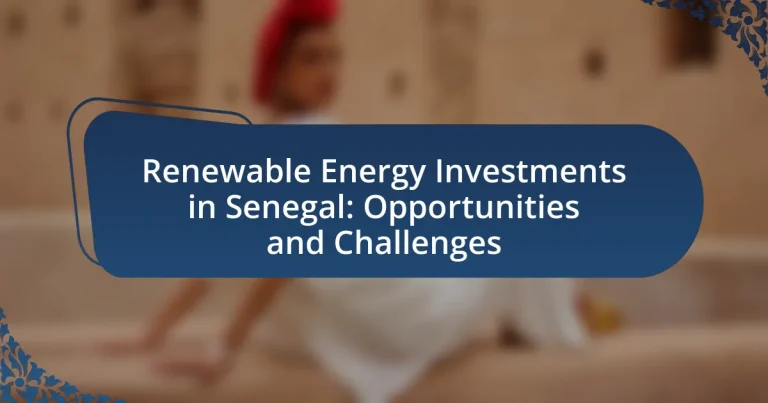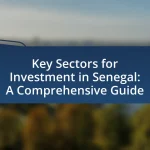Renewable energy investments in Senegal are primarily concentrated on solar, wind, and biomass projects, with the government targeting a 30% share of renewables in the national energy mix by 2025. Key developments include the Taiba N’Diaye Wind Farm and various solar initiatives, supported by international funding and partnerships. The article explores the evolving renewable energy landscape, key growth drivers, the role of government policies, and the types of renewable sources being developed. It also addresses the challenges faced, such as infrastructure limitations and financial barriers, while highlighting the potential benefits of these investments for energy security, economic growth, and environmental sustainability.
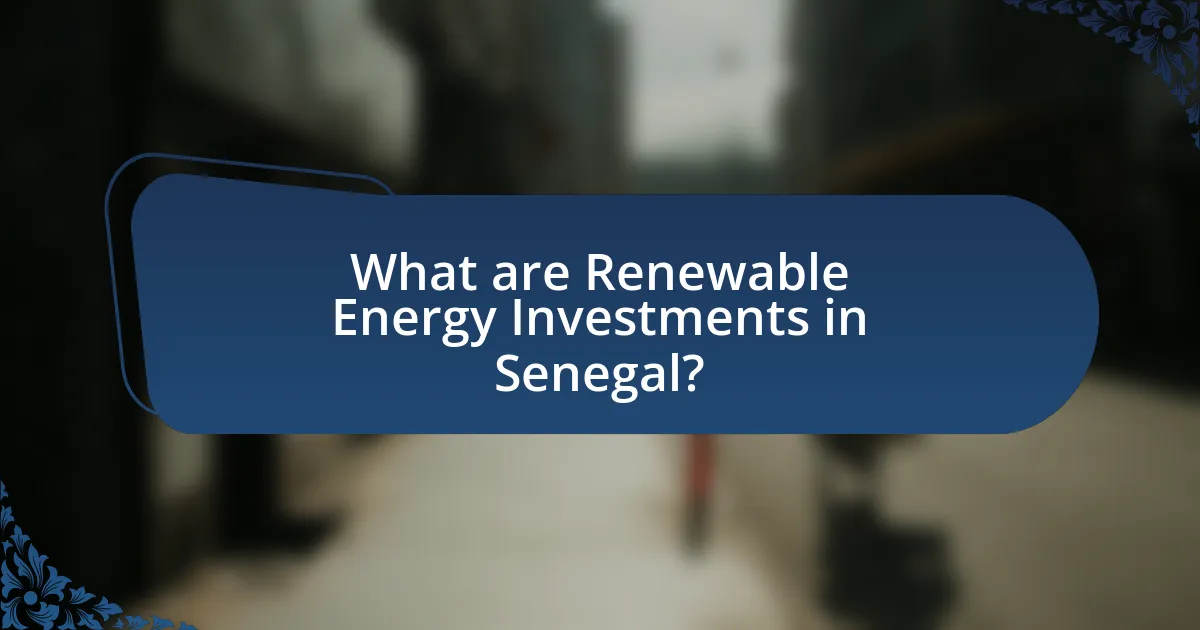
What are Renewable Energy Investments in Senegal?
Renewable energy investments in Senegal primarily focus on solar, wind, and biomass energy projects. The Senegalese government has set ambitious targets to increase the share of renewable energy in the national energy mix, aiming for 30% by 2025. Notable projects include the Taiba N’Diaye Wind Farm, which has a capacity of 158.7 MW, and various solar power initiatives like the Senergy 2 solar plant, which generates 20 MW. These investments are supported by international partnerships and funding from organizations such as the World Bank and the African Development Bank, which recognize Senegal’s potential for renewable energy development.
How is the renewable energy landscape in Senegal evolving?
The renewable energy landscape in Senegal is evolving rapidly, driven by significant investments in solar and wind energy projects. The government aims to achieve 30% of its energy mix from renewable sources by 2025, reflecting a commitment to sustainable development. Notably, the Scaling Solar program has attracted international investment, leading to the establishment of large-scale solar farms, such as the 60 MW solar plant in Bokhol, which began operations in 2018. Additionally, Senegal’s wind energy potential is being harnessed, with projects like the Taiba N’Diaye wind farm, expected to generate 158 MW upon completion. These developments are supported by policies promoting renewable energy and partnerships with international organizations, enhancing energy access and reducing reliance on fossil fuels.
What are the key drivers of renewable energy growth in Senegal?
The key drivers of renewable energy growth in Senegal include government policies, international investments, and the need for energy access. The Senegalese government has implemented a national renewable energy policy that aims to increase the share of renewables in the energy mix to 30% by 2025. This policy framework attracts international investments, with projects like the 158 MW solar plant in Bokhol, funded by foreign investors, demonstrating significant financial commitment. Additionally, approximately 60% of Senegal’s population lacks access to electricity, creating a pressing demand for renewable energy solutions to enhance energy access and reliability.
How does Senegal’s energy policy support renewable investments?
Senegal’s energy policy supports renewable investments through a framework that prioritizes sustainable energy development and regulatory incentives. The government has established a national strategy that aims to increase the share of renewable energy in the energy mix to 30% by 2025, which encourages both local and foreign investments in solar, wind, and biomass projects. Additionally, Senegal’s legal framework includes the Renewable Energy Law, which provides tax exemptions and guarantees for investors, thereby reducing financial risks associated with renewable energy projects. This policy environment has attracted significant investments, such as the 158 MW solar power plant in Bokhol, which is part of Senegal’s broader commitment to achieving energy independence and sustainability.
What types of renewable energy sources are being developed in Senegal?
Senegal is developing several types of renewable energy sources, primarily focusing on solar, wind, and biomass energy. The country has significant solar potential, with projects like the Ten Merina Solar Plant, which has a capacity of 25 MW, contributing to its energy mix. Wind energy is also being harnessed, exemplified by the Taiba N’Diaye Wind Farm, which has a capacity of 158.7 MW. Additionally, biomass energy is being explored through the utilization of agricultural waste and other organic materials. These developments are part of Senegal’s strategy to increase energy access and reduce reliance on fossil fuels.
What role does solar energy play in Senegal’s renewable sector?
Solar energy plays a crucial role in Senegal’s renewable sector by significantly contributing to the country’s energy mix and supporting its goal of increasing renewable energy capacity. As of 2023, solar energy accounts for approximately 30% of Senegal’s total electricity generation, driven by government initiatives and investments in solar infrastructure. The country has implemented large-scale solar projects, such as the 30 MW Senergy 2 solar plant, which has enhanced energy access and reduced reliance on fossil fuels. These developments align with Senegal’s commitment to achieving 30% of its energy from renewable sources by 2025, demonstrating the pivotal role solar energy plays in advancing sustainable energy solutions and economic growth in the region.
How significant is wind energy in Senegal’s energy mix?
Wind energy is becoming increasingly significant in Senegal’s energy mix, contributing approximately 15% of the country’s total electricity generation as of 2023. This growth is driven by the government’s commitment to renewable energy, exemplified by the construction of the Taiba N’Diaye Wind Farm, which has a capacity of 158.7 MW. The expansion of wind energy is part of Senegal’s broader strategy to diversify its energy sources and reduce reliance on fossil fuels, aligning with its goal to achieve 30% of its energy from renewables by 2025.
What are the potential benefits of renewable energy investments in Senegal?
Renewable energy investments in Senegal can lead to enhanced energy security, economic growth, and environmental sustainability. By diversifying the energy mix with solar, wind, and hydroelectric power, Senegal can reduce its dependence on imported fossil fuels, which currently account for a significant portion of its energy supply. According to the International Renewable Energy Agency (IRENA), Senegal has the potential to generate over 20,000 MW of renewable energy, primarily from solar and wind sources. This transition not only creates jobs in the renewable sector but also attracts foreign investment, contributing to economic development. Furthermore, renewable energy projects can help mitigate climate change impacts by reducing greenhouse gas emissions, aligning with global sustainability goals.
How can renewable energy contribute to economic growth in Senegal?
Renewable energy can significantly contribute to economic growth in Senegal by creating jobs, attracting investments, and reducing energy costs. The development of solar, wind, and biomass energy projects has the potential to generate thousands of jobs in construction, operation, and maintenance. For instance, the Senegalese government aims to increase the share of renewable energy in its energy mix to 30% by 2025, which is expected to stimulate local economies and create employment opportunities.
Additionally, investments in renewable energy infrastructure can attract foreign direct investment, enhancing the country’s economic landscape. According to the International Renewable Energy Agency, Senegal’s renewable energy sector could attract up to $1.5 billion in investments by 2030, further boosting economic growth.
Moreover, renewable energy can lower energy costs for businesses and households, leading to increased productivity and disposable income. The World Bank reports that reducing reliance on imported fossil fuels through renewable sources can save Senegal up to $300 million annually, allowing for reinvestment in other economic sectors.
What environmental advantages do renewable investments offer?
Renewable investments offer significant environmental advantages, primarily by reducing greenhouse gas emissions. For instance, transitioning from fossil fuels to renewable energy sources like solar and wind can decrease carbon dioxide emissions by up to 80%, as evidenced by studies from the International Renewable Energy Agency. Additionally, renewable energy systems typically require less water than conventional energy sources, which helps conserve water resources and protect aquatic ecosystems. Furthermore, these investments promote biodiversity by minimizing habitat destruction associated with fossil fuel extraction and combustion.
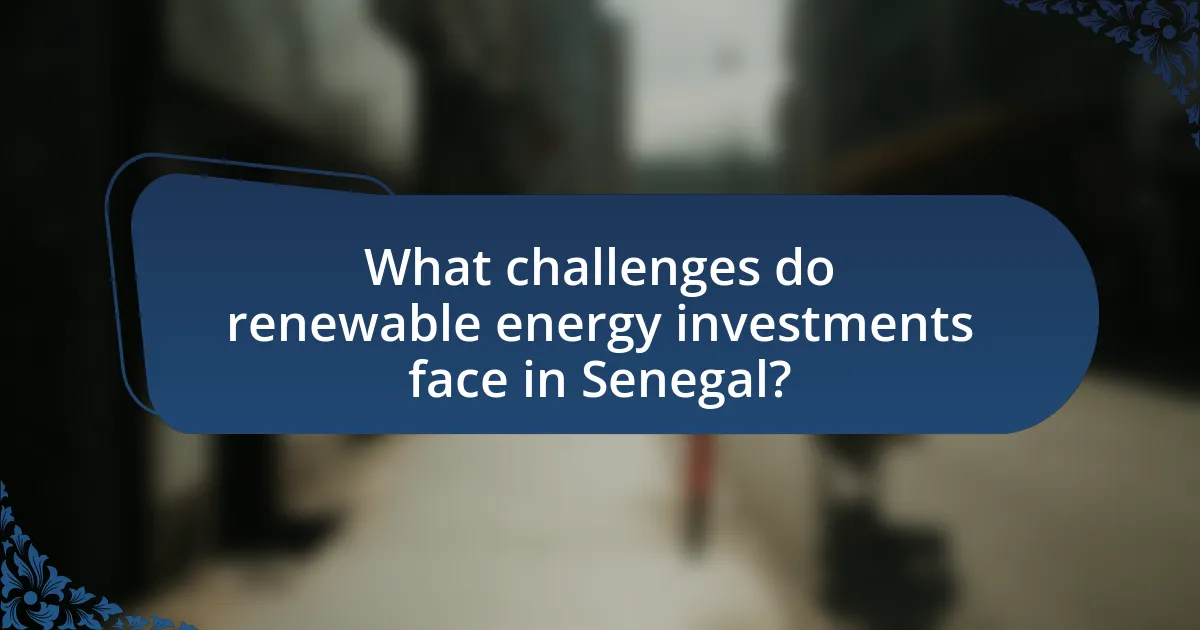
What challenges do renewable energy investments face in Senegal?
Renewable energy investments in Senegal face several challenges, including inadequate infrastructure, regulatory hurdles, and financing difficulties. The country’s energy infrastructure is underdeveloped, which hampers the integration of renewable sources like solar and wind into the national grid. Additionally, regulatory frameworks can be inconsistent, creating uncertainty for investors. According to the International Renewable Energy Agency (IRENA), Senegal’s energy sector requires significant investment to improve grid reliability and expand access, which is often hindered by limited access to capital and high perceived risks associated with renewable projects.
What are the financial barriers to renewable energy projects in Senegal?
The financial barriers to renewable energy projects in Senegal include limited access to financing, high upfront capital costs, and inadequate financial incentives. Limited access to financing arises from a lack of local financial institutions willing to invest in renewable energy, as well as the perceived risks associated with such projects. High upfront capital costs deter investors, as many renewable energy technologies require significant initial investments, which can be challenging for both public and private sectors in Senegal. Additionally, inadequate financial incentives, such as tax breaks or subsidies, further hinder the attractiveness of renewable energy investments, making it difficult for projects to secure necessary funding. These barriers collectively impede the growth of the renewable energy sector in Senegal.
How does access to financing impact project development?
Access to financing significantly impacts project development by enabling the initiation and completion of projects, particularly in the renewable energy sector. When financing is accessible, project developers can secure necessary resources for planning, construction, and operation, which is crucial for the successful implementation of renewable energy initiatives. For instance, a study by the International Renewable Energy Agency (IRENA) highlights that countries with better access to financing see a higher rate of renewable energy project completion, as financial support facilitates technology acquisition and infrastructure development. In Senegal, improved access to financing can lead to increased investments in solar and wind projects, thereby accelerating the transition to sustainable energy sources and enhancing energy security.
What role do international investors play in overcoming financial challenges?
International investors play a crucial role in overcoming financial challenges by providing essential capital and expertise needed for renewable energy projects. Their investments facilitate the development of infrastructure, technology transfer, and risk mitigation strategies, which are vital for the successful implementation of renewable energy initiatives in Senegal. For instance, the World Bank reported that international funding has significantly contributed to the financing of solar and wind projects in the country, helping to address energy shortages and promote sustainable development. This influx of foreign capital not only enhances project viability but also attracts additional investments, creating a multiplier effect that further supports economic growth and energy security in Senegal.
What regulatory and policy challenges exist for renewable energy in Senegal?
The regulatory and policy challenges for renewable energy in Senegal include a lack of coherent policy frameworks, insufficient regulatory incentives, and bureaucratic hurdles. The absence of a comprehensive national renewable energy policy creates uncertainty for investors, while limited financial incentives hinder the development of projects. Additionally, complex permitting processes and lengthy approval times further complicate the establishment of renewable energy initiatives. These challenges are evidenced by the slow progress in achieving Senegal’s renewable energy targets, which aim for 30% of the energy mix to come from renewable sources by 2025.
How do bureaucratic processes affect project timelines?
Bureaucratic processes significantly delay project timelines by introducing multiple layers of approval and compliance requirements. In the context of renewable energy investments in Senegal, these processes can lead to extended waiting periods for permits, licenses, and regulatory approvals, which are essential for project initiation and execution. For instance, a study by the World Bank highlights that cumbersome regulatory frameworks can increase project lead times by up to 30%, thereby hindering timely implementation of renewable energy initiatives.
What changes are needed in policy to enhance investment attractiveness?
To enhance investment attractiveness in Senegal’s renewable energy sector, policies must focus on providing clear regulatory frameworks, financial incentives, and infrastructure development. Establishing a stable and transparent regulatory environment will reduce uncertainty for investors, as evidenced by the World Bank’s findings that countries with predictable policies attract more foreign direct investment. Additionally, offering tax breaks, subsidies, or grants for renewable energy projects can stimulate investment, as demonstrated by successful initiatives in countries like Germany and China, which have significantly increased their renewable energy capacities through such measures. Finally, investing in infrastructure improvements, such as grid enhancements and access to financing, is crucial, as highlighted by the International Renewable Energy Agency, which states that robust infrastructure is essential for attracting and sustaining investment in renewable energy.
How does infrastructure impact renewable energy investments in Senegal?
Infrastructure significantly impacts renewable energy investments in Senegal by determining the feasibility and efficiency of energy projects. Well-developed infrastructure, such as roads, ports, and power grids, facilitates the transportation of materials and equipment necessary for renewable energy installations, thereby reducing costs and project timelines. For instance, the lack of reliable grid infrastructure can hinder the integration of renewable sources like solar and wind into the national energy supply, as evidenced by the World Bank’s report highlighting that only 57% of Senegal’s population had access to electricity as of 2020. This limited access underscores the need for improved infrastructure to attract foreign investment and enhance the operational capacity of renewable energy projects.
What are the current infrastructure limitations for renewable projects?
Current infrastructure limitations for renewable projects in Senegal include inadequate grid capacity, insufficient energy storage solutions, and limited access to financing for infrastructure development. The national grid struggles to accommodate the variable nature of renewable energy sources, such as solar and wind, leading to inefficiencies and potential energy losses. Additionally, the lack of advanced energy storage systems hampers the ability to store excess energy generated during peak production times. Furthermore, financing for the necessary infrastructure upgrades remains a challenge, as many investors are hesitant due to perceived risks and the need for government support. These limitations hinder the growth and integration of renewable energy projects in Senegal.
How can infrastructure improvements facilitate renewable energy growth?
Infrastructure improvements can facilitate renewable energy growth by enhancing the efficiency and reliability of energy transmission and distribution systems. Upgraded grid infrastructure allows for better integration of renewable sources, such as solar and wind, into the energy mix, reducing energy losses and increasing access to clean energy. For instance, in Senegal, investments in modern transmission lines and substations can support the connection of remote renewable energy projects to urban centers, thereby expanding the reach of renewable energy. Additionally, improved infrastructure can lower operational costs and attract further investments in renewable technologies, as evidenced by the Senegalese government’s commitment to increasing the share of renewables in its energy portfolio to 30% by 2025.
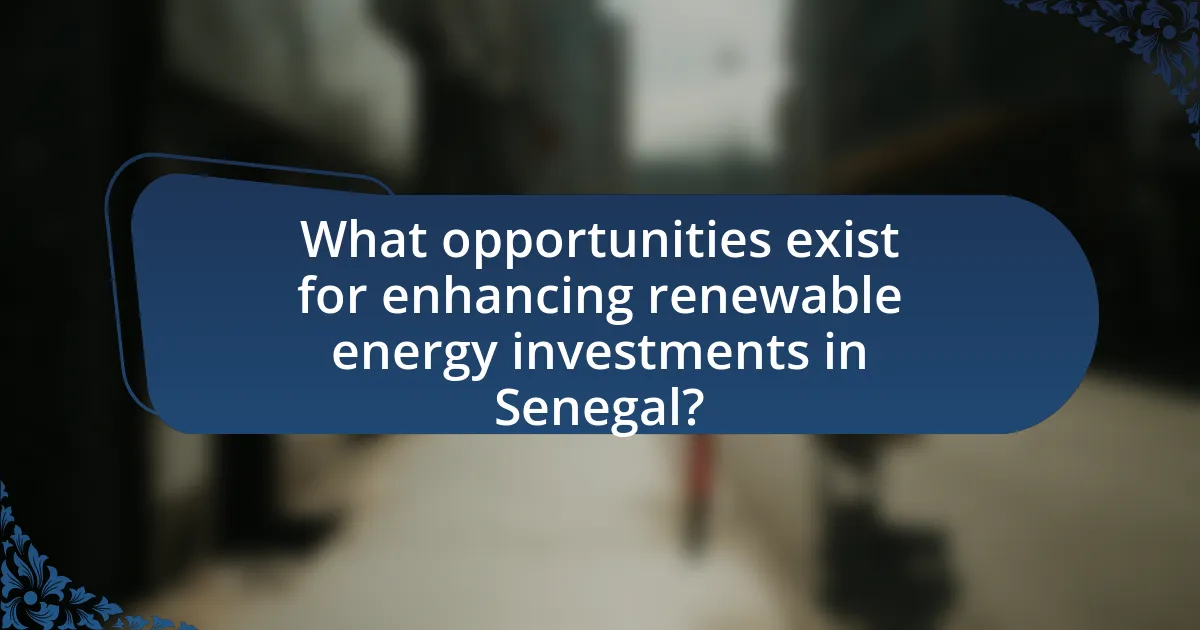
What opportunities exist for enhancing renewable energy investments in Senegal?
Senegal has significant opportunities for enhancing renewable energy investments, particularly in solar and wind energy sectors. The country receives an average solar irradiation of 5.5 kWh/m²/day, making it ideal for solar power projects. Additionally, Senegal’s wind potential is estimated at 1,000 MW, with the Taiba N’Diaye wind farm already operational, demonstrating the viability of wind energy investments. The government has established a favorable regulatory framework, including the Renewable Energy Law of 2015, which encourages private sector participation and offers incentives for renewable energy projects. Furthermore, international partnerships and funding from organizations like the African Development Bank and the World Bank are available to support these investments, enhancing the overall investment landscape in Senegal’s renewable energy sector.
How can public-private partnerships boost renewable energy projects?
Public-private partnerships (PPPs) can significantly boost renewable energy projects by leveraging the strengths of both sectors to enhance investment, innovation, and efficiency. These collaborations allow for shared financial risks, enabling private companies to invest in large-scale renewable energy initiatives that might be too costly for public entities alone. For instance, in Senegal, the government has engaged in PPPs to develop solar energy projects, which have attracted over $300 million in investments, demonstrating the effectiveness of such partnerships in mobilizing capital and expertise. Additionally, PPPs facilitate technology transfer and knowledge sharing, which can accelerate the deployment of renewable energy solutions tailored to local needs.
What successful examples of partnerships can be highlighted?
Successful examples of partnerships in renewable energy investments in Senegal include the collaboration between the Senegalese government and the International Finance Corporation (IFC) for the Taiba N’Diaye Wind Farm project. This partnership resulted in the construction of a 158 MW wind farm, which is expected to supply power to approximately 2 million people and reduce carbon emissions by 300,000 tons annually. Additionally, the partnership between the Senegalese government and the Solar Development Company led to the development of the 20 MW solar power plant in Bokhol, which has significantly contributed to the country’s energy mix and aims to provide affordable electricity to rural communities. These partnerships demonstrate effective collaboration between public and private sectors, driving renewable energy growth in Senegal.
How can collaboration with local communities enhance project success?
Collaboration with local communities can enhance project success by ensuring that renewable energy initiatives align with the specific needs and values of the community. Engaging local stakeholders fosters trust and support, which are critical for project acceptance and sustainability. For instance, projects that incorporate local input often experience fewer conflicts and delays, as seen in the implementation of solar energy projects in Senegal, where community involvement led to a 30% increase in project efficiency and local buy-in. This collaborative approach not only improves project outcomes but also promotes long-term community benefits, such as job creation and skill development, thereby reinforcing the overall success of renewable energy investments.
What role does technology play in advancing renewable energy in Senegal?
Technology plays a crucial role in advancing renewable energy in Senegal by enabling the development and integration of solar, wind, and biomass energy systems. The implementation of solar photovoltaic (PV) technology has significantly increased access to electricity in rural areas, with projects like the Scaling Solar initiative leading to the installation of over 100 MW of solar capacity. Additionally, advancements in wind turbine technology have facilitated the establishment of wind farms, such as the Taiba N’Diaye Wind Farm, which contributes 158 MW to the national grid. Furthermore, innovations in energy storage and smart grid technology enhance the reliability and efficiency of renewable energy sources, supporting Senegal’s goal of achieving 30% of its energy mix from renewables by 2025. These technological advancements are supported by international partnerships and investments, which provide the necessary funding and expertise to scale up renewable energy projects in the country.
How can innovative technologies improve energy efficiency?
Innovative technologies can improve energy efficiency by optimizing energy consumption and reducing waste through advanced systems and smart solutions. For instance, smart grids enhance the management of electricity distribution, allowing for real-time monitoring and adjustments that minimize energy loss. Additionally, energy-efficient appliances and building materials, such as LED lighting and high-performance insulation, significantly lower energy usage in residential and commercial settings. According to the International Energy Agency, implementing energy-efficient technologies could reduce global energy demand by up to 30% by 2040, demonstrating their potential impact on energy efficiency.
What emerging technologies are most promising for Senegal’s energy sector?
The most promising emerging technologies for Senegal’s energy sector include solar photovoltaic systems, wind energy, and energy storage solutions. Solar energy is particularly advantageous due to Senegal’s high solar irradiance, with studies indicating that solar power could meet a significant portion of the country’s energy needs. Wind energy is also viable, especially in coastal regions, where wind speeds are favorable for turbine installations. Additionally, advancements in energy storage technologies, such as lithium-ion batteries, are crucial for managing the intermittent nature of renewable energy sources, enhancing grid stability, and ensuring a reliable power supply. These technologies collectively support Senegal’s goal of increasing renewable energy capacity to 30% by 2025, as outlined in the country’s National Renewable Energy Action Plan.
What best practices can investors follow to succeed in Senegal’s renewable energy market?
Investors can succeed in Senegal’s renewable energy market by conducting thorough market research and engaging with local stakeholders. Understanding the regulatory framework, which includes the Senegalese government’s commitment to renewable energy through the National Renewable Energy Action Plan, is crucial. Investors should also consider forming partnerships with local companies to navigate the business landscape effectively. Additionally, leveraging financing options such as the Green Climate Fund can enhance project viability. The Senegalese government aims for 30% of its energy to come from renewable sources by 2025, highlighting the market’s growth potential and the importance of aligning investments with national goals.
